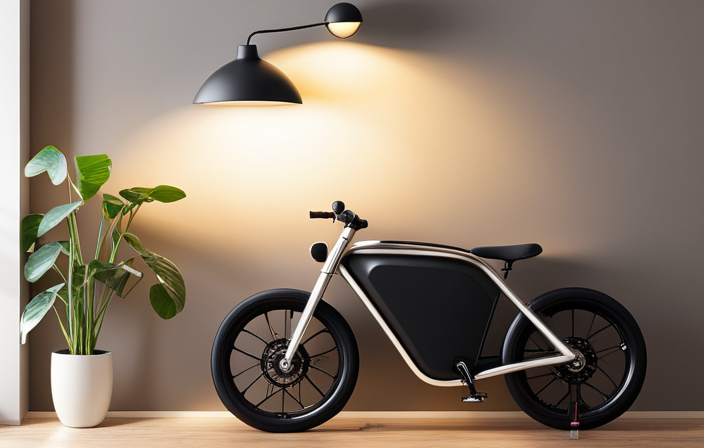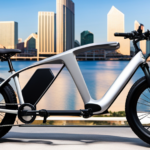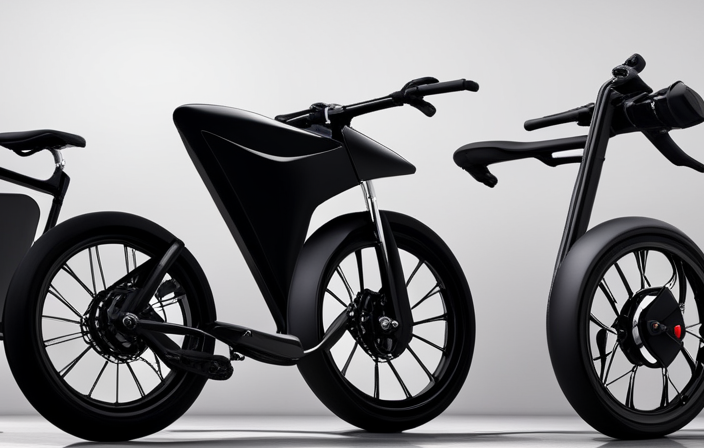Charging your electric bike battery at home is a simple and convenient way to ensure you have a reliable power source for your rides.
As a bike enthusiast, I understand the importance of knowing how to properly charge your battery to maximize its lifespan and performance.
In this article, I will guide you through the step-by-step process of charging your electric bike battery at home, providing you with the knowledge and confidence to keep your battery powered up and ready to go.
Key Takeaways
- Maintain proper ventilation and avoid charging in direct sunlight or near flammable materials
- Use the manufacturer-provided charger and regularly inspect it for damage
- Disconnect the charger once the battery is fully charged to prevent overcharging
- Consider investing in a backup battery or charger for peace of mind and extended ride duration
Understand your battery type and charging requirements
Before you start charging your electric bike battery at home, it’s crucial to understand the type of battery you have and its specific charging requirements. This knowledge will ensure efficient battery maintenance and charging efficiency.
Different types of electric bike batteries, such as lithium-ion or lead-acid, have distinct characteristics and charging needs. For instance, lithium-ion batteries require a specific voltage and current range for optimal charging, while lead-acid batteries may need a longer charging time. Understanding these requirements will prevent overcharging or undercharging, which can negatively impact your battery’s lifespan and performance.
Once you have a clear understanding of your battery type and charging needs, you can find a suitable charging location in your home, ensuring ease of access and safety.
Find a suitable charging location in your home
First, let’s identify a convenient spot in your place where you can easily power up your e-bike. Finding a suitable charging location is crucial for efficient and safe charging of your electric bike battery. Here are a few factors to consider when selecting a spot:
| Location Considerations | Safety Precautions |
|---|---|
| Near an electrical outlet | Avoid overloading circuits |
| Well-ventilated area | Prevent overheating |
| Away from flammable materials | Reduce fire risks |
| Stable and flat surface | Prevent accidental falls |
| Protected from extreme weather | Ensure battery longevity |
By adhering to these safety precautions, you can create an ideal charging location that meets your needs. Once you have identified the spot, you’ll be ready to gather the necessary charging equipment and begin the charging process.
Gather the necessary charging equipment
Now let’s gather all the equipment you’ll need to conveniently power up your e-bike.
When it comes to charging equipment options, there are a few choices available. The most common option is a standard charger that comes with your electric bike. This charger plugs into a regular electrical outlet and is simple to use.
Another option is a fast charger, which can charge your battery in a shorter amount of time but may require a special outlet.
It’s important to note that using the proper charging techniques is crucial for the longevity and performance of your battery. Remember to always follow the manufacturer’s guidelines and avoid overcharging.
Once you have gathered the necessary charging equipment, you can move on to the next step: connecting the charger to the battery.
Connect the charger to the battery
To conveniently power up your e-bike, all you need to do is plug the charger into the outlet and connect it to the waiting battery.
Once you have gathered the necessary charging equipment, connecting the charger to the battery is a straightforward process. Start by locating the charging port on your e-bike, usually located near the battery. Take the charger and align the plug with the charging port, ensuring a secure fit. Once connected, you will notice a light indicator on the charger, indicating that the charging process has begun.
It’s important to note that the charging speed may vary depending on the battery and charger specifications. If you encounter any issues, such as the charger not working or the battery not charging properly, consult the manufacturer’s manual or contact customer support for troubleshooting guidance.
With the charger successfully connected to the battery, you can now proceed to the next step: plugging the charger into a power outlet.
Plug the charger into a power outlet
Once you’ve connected the charger to the waiting battery, it’s time to find a nearby power outlet to plug it into.
When selecting a power outlet, it is important to consider charging safety and the battery lifespan. Ensure that the power outlet you choose is in good condition and can handle the charging requirements of your electric bike battery.
It is recommended to use a grounded outlet and avoid using extension cords or power strips, as they can pose a safety risk. By plugging the charger directly into a power outlet, you can minimize the chances of any electrical mishaps.
Remember, proper charging practices can help prolong the lifespan of your battery.
Now that the charger is securely plugged in, let’s move on to the next step of monitoring the charging progress.
Monitor the charging progress
Keep an eye on how your battery is juicing up by monitoring the charging progress. It’s important to know the monitoring techniques and understand the charging indicators to ensure a proper charge. To help you visualize the charging progress, refer to the table below:
| Indicator | Meaning |
|---|---|
| Solid Green | Battery is fully charged |
| Flashing Red | Battery is critically low |
| Flashing Green | Battery is charging |
| Solid Red | Battery is not charging or there is an issue |
By monitoring the charging progress, you can ensure that your electric bike battery is charging effectively and safely. Once you have a solid understanding of the charging indicators, you can move on to the next step and follow the recommended charging time for your specific battery. This will help maintain the longevity and performance of your battery.
Follow the recommended charging time
Make sure to follow the recommended charging time to maintain the longevity and performance of your battery.
The optimal charging methods for an electric bike battery include charging it fully after each use and avoiding partial charging.
It is important to note that overcharging the battery can lead to decreased battery life and potential damage.
To ensure proper battery maintenance, it is recommended to use the charger provided by the manufacturer and avoid using third-party chargers.
Additionally, it is advisable to store the battery in a cool and dry place when not in use.
By following these battery maintenance tips and adhering to the recommended charging time, you can maximize the lifespan and efficiency of your electric bike battery.
Avoiding overcharging the battery is crucial to prevent any potential harm and maintain optimal performance.
Avoid overcharging the battery
To prevent any potential harm and maintain optimal performance, it’s essential to avoid overcharging your battery. Overcharging can lead to reduced battery life, decreased capacity, and even safety hazards. Here are four reasons why avoiding overcharging is crucial:
-
Longer battery lifespan: By following the recommended charging time and avoiding overcharging, you can extend the overall lifespan of your electric bike battery.
-
Improved battery capacity: Overcharging can cause the battery to lose its maximum capacity over time. Proper charging helps maintain the battery’s ability to hold a charge, ensuring longer rides.
-
Enhanced safety: Overcharging can generate excessive heat, leading to potential safety risks such as battery swelling, leaking, or even exploding. Charging your battery correctly helps minimize these risks.
-
Cost savings: By avoiding overcharging, you can avoid premature battery replacement, saving you money in the long run.
By understanding the benefits of proper charging and avoiding overcharging, you can ensure your electric bike battery performs optimally. Now let’s discuss the next step: ensuring proper ventilation during charging.
Ensure proper ventilation during charging
Ensuring proper ventilation during charging is essential for maintaining the performance and safety of your electric bike battery. Proper ventilation allows for the dissipation of heat generated during the charging process, preventing the battery from overheating. This is crucial because excessive heat can degrade the battery’s performance and even lead to a safety hazard, such as a fire.
To ensure proper ventilation, it is recommended to charge your electric bike battery in a well-ventilated area, away from flammable materials and direct sunlight. Additionally, avoid covering the battery or obstructing the air vents while charging.
By following these guidelines, you can ensure that your electric bike battery charges safely and efficiently.
Moving on to taking safety precautions while charging, it is important to…
Take safety precautions while charging
One interesting statistic to note is that approximately 50% of electrical fires are caused by improper charging practices. To ensure safety while charging your electric bike battery, it is crucial to follow these charging safety tips:
- Always use the charger provided by the manufacturer.
- Avoid charging the battery near flammable materials.
- Never leave the battery unattended while charging.
- Regularly inspect the charger and cable for any signs of damage.
- Do not overcharge the battery; follow the recommended charging time.
Common charging mistakes include using incompatible chargers, charging in extreme temperatures, and leaving the battery connected for extended periods. By taking these safety precautions, you can significantly reduce the risk of accidents and prolong the lifespan of your electric bike battery.
Once the battery is fully charged, it is important to disconnect the charger to prevent overcharging and potential damage.
Disconnect the charger once the battery is fully charged
After the battery reaches its full capacity, it’s crucial to disconnect the charger to prevent any potential damage or overcharging. This step is essential for proper battery maintenance and to ensure a longer battery lifespan.
Leaving the charger connected to the battery even after it’s fully charged can lead to overheating, which can degrade the battery’s performance over time. Overcharging can also shorten the battery’s overall lifespan. Therefore, it’s important to be diligent in monitoring the charging process and disconnecting the charger as soon as the battery is fully charged.
By taking this simple precaution, you can protect your battery and maximize its longevity.
Once the charger is disconnected, the next step is to store the battery in a cool and dry place.
Store the battery in a cool and dry place
Once the battery is fully charged, it is important to disconnect the charger to avoid overcharging and potential damage to the battery.
Now, let’s move on to the next step in maintaining your electric bike battery: storing the battery in a cool and dry place. This is crucial for ensuring the longevity and optimal performance of your battery.
Extreme temperatures, both hot and cold, can affect the battery’s capacity and overall lifespan. Therefore, it is recommended to store the battery in a location where the temperature remains stable and within the manufacturer’s recommended range. Additionally, keeping the battery in a dry place will help prevent any moisture damage.
By following these guidelines for storing your battery safely, you can extend its lifespan and enjoy consistent performance on your electric bike.
Now, let’s discuss how to regularly check the battery’s charging performance.
Regularly check the battery’s charging performance
To ensure your battery stays in optimal condition, it’s important to regularly monitor how well it charges. One way to do this is by checking the battery voltage.
Use a voltmeter to measure the voltage output of your battery. A fully charged electric bike battery should have a voltage reading within the manufacturer’s specified range. If the voltage is too low, it may indicate that the battery is not charging properly or that it is losing capacity.
In addition to checking the voltage, it’s also a good idea to periodically test the battery capacity. This can be done by fully charging the battery and then discharging it through a ride. Pay attention to how long the battery lasts and if it is able to maintain power throughout the ride.
If you notice any significant decrease in capacity, it may be time to consider investing in a backup battery or charger.
Consider investing in a backup battery or charger
Investing in a backup battery or charger will provide you with peace of mind and ensure that you never run out of power when you’re out exploring on your electric bike. Having a backup battery is especially useful if you plan on going on long rides or if you rely on your electric bike for commuting. A backup battery can be easily carried with you and swapped out when your main battery is running low. Additionally, having a backup charger can be beneficial if you have access to multiple power outlets or if you plan on charging your battery at a friend’s house. By investing in these backup options, you can avoid the frustration of being stranded with a dead battery and continue enjoying your electric bike adventures.
| Backup Battery Benefits | Alternative Charging Methods |
|---|---|
| Peace of mind | Power outlets |
| Extended ride duration | Friend’s house |
| Convenient |
To ensure the best charging performance for your electric bike battery, it’s important to consult the manufacturer’s guidelines for any specific charging instructions.
Consult the manufacturer’s guidelines for any specific charging instructions
Make sure you peruse the manufacturer’s guidelines for any specific instructions on how to juice up your e-bike without turning it into a ticking time bomb.
Battery maintenance and charging safety are crucial aspects to consider when charging your electric bike at home. The manufacturer’s guidelines will provide you with important information about the ideal charging methods and precautions to take.
It is essential to follow these instructions to ensure the longevity and optimal performance of your battery. Some manufacturers may recommend charging the battery to a certain level before plugging it in, while others may suggest avoiding overcharging. Additionally, they may advise against charging the battery in extreme temperatures or using incompatible chargers.
By consulting the manufacturer’s guidelines, you can charge your electric bike battery safely and efficiently, avoiding any potential risks.
Frequently Asked Questions
How long does it usually take to fully charge an electric bike battery?
It usually takes several hours to fully charge an electric bike battery, depending on various factors such as battery capacity, charger output, and current charge level. These factors can affect the charging time significantly.
Can I charge my electric bike battery overnight?
Yes, you can charge your electric bike battery overnight. However, it’s important to be cautious as it may affect the battery lifespan. Proper charging techniques and using a reliable charger can help maintain the battery’s health.
Is it safe to charge my electric bike battery in a garage?
It is generally safe to charge an electric bike battery in a garage, but it is important to take proper charging precautions. However, if you have concerns, there are alternative charging locations available to ensure safety.
What should I do if I notice any abnormalities during the charging process?
If I notice any abnormalities during the charging process, I would immediately unplug the battery and contact a professional for troubleshooting tips. Safety precautions are crucial to prevent any potential risks or damage.
Are there any maintenance tasks I should perform regularly to ensure optimal battery performance?
To ensure optimal battery performance, regular battery maintenance is essential. This may include checking and cleaning the battery terminals, keeping the battery at the recommended temperature range, and avoiding overcharging or deep discharging.
Conclusion
After following these steps, I’ve successfully charged my electric bike battery at home. It was such a satisfying experience to see the battery slowly filling up with energy, like a flower absorbing sunlight and blooming.
I now feel confident in maintaining my electric bike’s battery and ensuring its longevity. Remember, taking care of your battery is essential for a smooth and enjoyable ride. So, don’t forget to regularly check its charging performance and refer to the manufacturer’s guidelines for any specific instructions.
Happy riding!
















